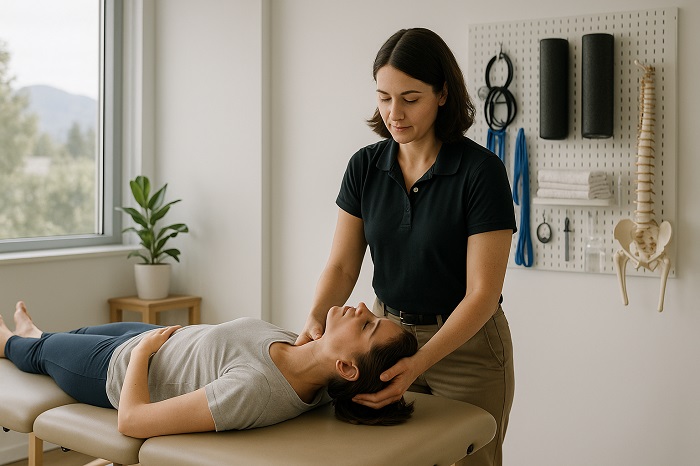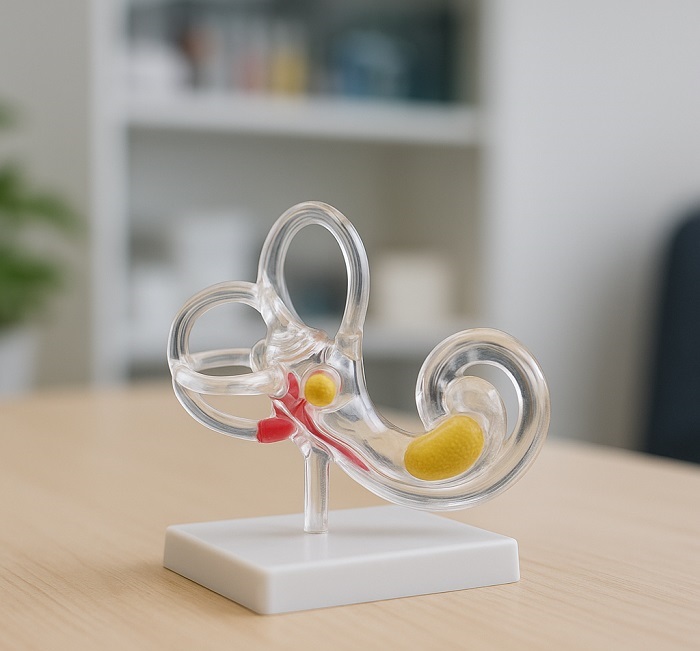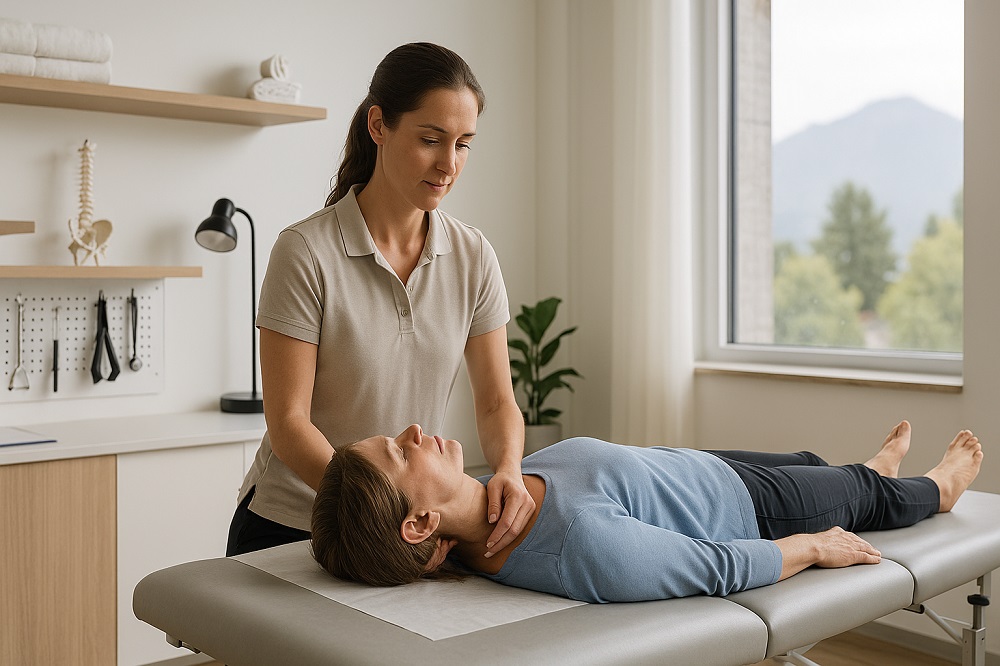Introduction:
Feeling like the room is spinning, unsteady on your feet, or slightly “off” after you move your head? You’re not alone—and you don’t have to live with it. Vestibular physiotherapy is a targeted, evidence-based approach that treats common causes of dizziness, vertigo, and imbalance, including BPPV (benign paroxysmal positional vertigo), vestibular migraine, and post-concussion dizziness. At Fortius Center in North Vancouver, our clinicians assess your symptoms, identify the root cause, and design a plan to restore your balance quickly and safely—so you can get back to daily life with confidence.
What Vestibular Physiotherapy Treats (and Why It Works)
Your vestibular system helps your brain understand where your head is in space. When it malfunctions, you can experience spinning, floating sensations, nausea, blurry vision, or feeling “drunk” or “on a boat.” Common treatable conditions include:
-
BPPV: Tiny calcium crystals (otoconia) move into a canal of the inner ear where they shouldn’t be. The result is brief, intense spinning with head movements (e.g., rolling in bed, looking up).
-
Unilateral vestibular hypofunction: One inner ear under-functions, causing imbalance, motion sensitivity, and visual blurring with head turns.
-
Vestibular migraine: Episodes of dizziness or vertigo with (or without) a traditional headache; often paired with light/sound sensitivity.
-
Post-concussion dizziness: A combination of vestibular, ocular, and neck contributions that prolong symptoms after a head injury.
-
Persistent postural-perceptual dizziness (PPPD): Non-spinning dizziness and unsteadiness that persist for months, often worse in busy visual environments.
Why physio helps: Vestibular physiotherapists use positional testing to pinpoint the problem and prescribe repositioning maneuvers, gaze-stability drills, and balance retraining. These methods promote central compensation—your brain’s ability to recalibrate and stabilize vision and balance.

Your First Appointment at Fortius Center (What to Expect)

We start with a detailed history: when symptoms began, what triggers them, how long they last, and any previous episodes, migraines, or head/neck injuries. Then we perform a focused exam that may include:
-
Oculomotor and vestibulo-ocular reflex testing
-
Positional tests (e.g., Dix-Hallpike and roll tests) to confirm BPPV and identify the affected canal
-
Gait and balance evaluation (e.g., single-leg stance, tandem stance, dynamic tasks)
-
Cervical screen to rule in/out neck contributions
-
Concussion screen if relevant (symptom clusters, exertional tolerance)
BPPV: The Quickest Win (and Why Google’s “Epley” Isn’t Always Enough)
BPPV is the most common cause of vertigo we see—and the one that often responds fastest. When otoconia (ear crystals) settle in a semicircular canal, they send false movement signals to the brain during certain head positions. The fix is mechanical: canalith repositioning maneuvers that guide the crystals back to the utricle where they belong.
- For posterior-canal BPPV (most common), we use the Epley or Semont maneuver.
- For horizontal-canal BPPV, we use BBQ roll (Lempert) or Gufoni.
- For anterior-canal BPPV, we select less common variations.
Why not just do a YouTube Epley at home? Because:
- Not all BPPV is posterior-canal; doing the wrong maneuver won’t help.
- The affected side matters. Self-treating the wrong side can prolong symptoms.
- Some patients have multi-canal or bilateral BPPV, or it recurs.
- Technique, timing, and post-maneuver instructions are crucial.
Good news: many BPPV cases improve in 1–3 visits with the correct maneuver plus short-term activity guidance and a simple home plan.
Beyond BPPV: Gaze Stability, Balance, and Motion Tolerance
When dizziness isn’t purely positional—or if you’ve had symptoms for weeks—your program will likely include:
Gaze-Stability Training
If rapid head turns make your vision bounce or blur (oscillopsia), we’ll retrain your vestibulo-ocular reflex (VOR) so your eyes can stay locked on a target when your head moves. Expect brief, frequent sets that progress in speed, duration, and background complexity.
Habituation & Motion Sensitivity Reduction
If certain movements or environments (grocery aisles, car rides) provoke symptoms, we use graded exposure. Carefully dosed, repeated exposure diminishes the system’s over-reaction and reduces discomfort.
Balance Retraining
We challenge your balance in a safe, progressive way: firm vs. soft surfaces, narrow stances, eyes closed, dynamic head turns, dual-tasking. This improves postural control and confidence.
Cervical (Neck) Integration
After concussions or whiplash, neck joints and muscles can mimic or magnify dizziness. We address cervical mobility, proprioception, and deep neck flexor control alongside vestibular drills.

Expected Timelines: How Long Does Recovery Take?

Timelines vary based on the diagnosis and how long you’ve had symptoms:
-
BPPV: Often major relief within 1–3 sessions, with occasional follow-ups for recurrences.
-
Unilateral hypofunction: Noticeable improvement within 2–4 weeks, with continued gains over 6–8 weeks.
-
Vestibular migraine: Progress depends on trigger management and medical co-care; physio eases motion sensitivity and balance issues over 4–8+ weeks.
-
Post-concussion dizziness: Many patients improve steadily across 4–10 weeks, especially when vestibular and cervical components are treated together.
-
PPPD: Improvement is gradual with education, graded exposure, vestibular therapy, and sometimes psychological support.
We’ll review your progress each visit, adjust the plan, and give clear milestones so you know what “better” looks like.
Home Care & Safety Tips (Do’s and Don’ts)
Do:
-
Keep a brief symptom log (what triggered dizziness, how long it lasted, any nausea/blurred vision).
-
Practice your assigned drills as prescribed; short, frequent sets work best.
-
Hydrate, sleep well, and maintain light daily activity as tolerated—motion is medicine for compensation.
-
For BPPV, follow post-maneuver guidance for the first 24 hours if prescribed.
Don’t:
-
Power through severe spins; rest, breathe, and resume when symptoms settle.
-
Self-treat with random maneuvers from the internet—get a proper diagnosis first.
- Avoid all movement for days; excessive rest can slow recovery.
Seek urgent medical care if you notice stroke-like symptoms (sudden weakness, facial droop, trouble speaking), new severe headache, fainting, double vision, or neurological changes.
Concussion-Related Dizziness: Step-By-Step Return
After a concussion, lingering dizziness can stem from the inner ear, the neck, the visual system—or all three. We tailor care across these pillars:
- Symptom-limited aerobic activity to improve cerebral blood flow without flaring symptoms.
- Vestibulo-ocular and visual rehab to restore tolerance to head movement and tracking.
-
Cervical management to address joint position sense and muscle control.
-
Staged return-to-learn/work/play with clear criteria and documentation.
This structured approach reduces uncertainty and keeps progress measurable.
FAQs (Clear Answers for Fast Decisions)
Is BPPV dangerous or just uncomfortable?
BPPV is typically benign—not dangerous—but symptoms can be intense and increase fall risk. Proper repositioning maneuvers are highly effective and safe when performed by a trained clinician.
How many sessions will I need?
BPPV often resolves in 1–3 visits. Hypofunction, migraine-related dizziness, and post-concussion cases usually require several weeks of progressive rehab.
Can exercises make dizziness worse?
Short-term symptom provocation is common and expected in habituation programs. We dose exercises so symptoms rise slightly, then settle within minutes. If symptoms linger or escalate, we adjust immediately.
Can I drive with dizziness?
If dizziness affects your vision, reaction time, or steadiness—don’t drive until symptoms are controlled. Ask your physiotherapist for personalized guidance.
Will vestibular therapy help vestibular migraine?
Yes—while medical and lifestyle measures remain crucial, vestibular therapy reduces motion sensitivity and improves balance and confidence between episodes.
Is vestibular physio covered by extended benefits?
Many plans in British Columbia cover physiotherapy. Check your plan details; we can provide receipts for reimbursement.
Why Choose Fortius Center in North Vancouver
-
Targeted assessment: We identify the exact driver (BPPV vs. hypofunction vs. migraine vs. post-concussion) and treat accordingly.
-
Evidence-based care: We use validated repositioning maneuvers and progressive VOR/balance training.
-
Integrated approach: When neck issues or concussion are involved, your plan includes cervical rehab and return-to-activity guidance.
-
Clear milestones: We map out your sessions, home plan, and expected timelines so you’re never guessing.
-
Local, convenient care: Centrally located in North Vancouver with easy access and options for extended benefits billing.
Your Next Step: Start Feeling Steady Again
Dizziness and vertigo can be frightening—but with the right diagnosis and plan, most people improve quickly. If you’re in North Vancouver and experiencing BPPV, vestibular migraine, post-concussion dizziness, or unexplained imbalance, book a vestibular physiotherapy assessment at Fortius Center today. We’ll confirm what’s going on and guide you step by step back to steady, confident movement.

